 Our last days in Namibia were spent considering the future for cheetahs. The big cats are the fastest animal on earth, being able to run in bursts as much as 120 km/hr. They can reach such speeds for 20-30 seconds. Then they have to capture their prey, often fleeing antelope, or stop as they quickly overheat. Too often a farmer’s goat is the target and here arises an existential challenge to the cheetah’s future in the wild.
Our last days in Namibia were spent considering the future for cheetahs. The big cats are the fastest animal on earth, being able to run in bursts as much as 120 km/hr. They can reach such speeds for 20-30 seconds. Then they have to capture their prey, often fleeing antelope, or stop as they quickly overheat. Too often a farmer’s goat is the target and here arises an existential challenge to the cheetah’s future in the wild. We visited two different groups working on this problem. First we stopped at the Cheetah Conservation Fund’s 44,000 hectare field site. There we delivered a large collection of medical supplies for their veterinarians. The creator and director of CCF, Dr. Laurie Marker, is a good friend of our UW Conservation Canines friend, Dr. Sam Wasser. Sam had put us in email contact with Laurie and we had gathered supplies from the Skagit Valley Vet Clinic and the Skagit Valley Farmer’s Supply. Where else would you go for 4 liters of betadine antiseptic?
We visited two different groups working on this problem. First we stopped at the Cheetah Conservation Fund’s 44,000 hectare field site. There we delivered a large collection of medical supplies for their veterinarians. The creator and director of CCF, Dr. Laurie Marker, is a good friend of our UW Conservation Canines friend, Dr. Sam Wasser. Sam had put us in email contact with Laurie and we had gathered supplies from the Skagit Valley Vet Clinic and the Skagit Valley Farmer’s Supply. Where else would you go for 4 liters of betadine antiseptic?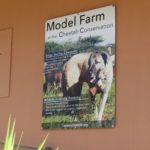 CCF’s mission is to develop ways that farmers and cheetahs can coexist and to educate in order to reduce poaching of wild cheetahs. They also have 6 or 8 cheetahs that have been rescued, mostly it seems from rich Arabs, and that will have to live in captivity for the rest of their lives.
CCF’s mission is to develop ways that farmers and cheetahs can coexist and to educate in order to reduce poaching of wild cheetahs. They also have 6 or 8 cheetahs that have been rescued, mostly it seems from rich Arabs, and that will have to live in captivity for the rest of their lives.CCF has developed a model goat farm and is working all over Namibia, teaching farmers their techniques. In short, bring the animals in at night and develop a goat-protection dog that is tough as nails and loves goats.  The dog they have settled on is an Anatolian breed as big as a small bear. CCF raises these dogs and sells them to farmers. The staff visit each dog several times in their first year in the field. Requests for dogs is running ahead of supply. We watched the current crowd of puppies gobble their food as they grow up and bond with CCF’s goats.
The dog they have settled on is an Anatolian breed as big as a small bear. CCF raises these dogs and sells them to farmers. The staff visit each dog several times in their first year in the field. Requests for dogs is running ahead of supply. We watched the current crowd of puppies gobble their food as they grow up and bond with CCF’s goats.
 The dog they have settled on is an Anatolian breed as big as a small bear. CCF raises these dogs and sells them to farmers. The staff visit each dog several times in their first year in the field. Requests for dogs is running ahead of supply. We watched the current crowd of puppies gobble their food as they grow up and bond with CCF’s goats.
The dog they have settled on is an Anatolian breed as big as a small bear. CCF raises these dogs and sells them to farmers. The staff visit each dog several times in their first year in the field. Requests for dogs is running ahead of supply. We watched the current crowd of puppies gobble their food as they grow up and bond with CCF’s goats. One hundred km away there is another huge effort for the cheetahs. The Africat Foundation has a 20,000 hectare property that they have set up so cheetahs can live a more-or-less natural life in this large fenced area. We had to go through three guarded gates to get to the lodge at Africat. The inner one is to keep freely-ranging cheetahs away from the guests.
One hundred km away there is another huge effort for the cheetahs. The Africat Foundation has a 20,000 hectare property that they have set up so cheetahs can live a more-or-less natural life in this large fenced area. We had to go through three guarded gates to get to the lodge at Africat. The inner one is to keep freely-ranging cheetahs away from the guests.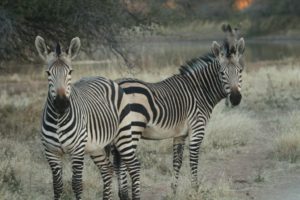 Just as we arrived, a tour was leaving the lodge and we hopped onto the open safari vehicle. The driver/guide told us about their efforts to re-wild captured cheetahs and we set off to try to find two brothers whose mother had been shot by a farmer. The farmer then gave the 2 three-week old cubs to Africat. Now these two were living on their own. Both have radio collars and our guide drove with one hand while he waved his tracking antenna this way and that trying to get a signal. After several kilometers of creeping around thorn bushes
Just as we arrived, a tour was leaving the lodge and we hopped onto the open safari vehicle. The driver/guide told us about their efforts to re-wild captured cheetahs and we set off to try to find two brothers whose mother had been shot by a farmer. The farmer then gave the 2 three-week old cubs to Africat. Now these two were living on their own. Both have radio collars and our guide drove with one hand while he waved his tracking antenna this way and that trying to get a signal. After several kilometers of creeping around thorn bushes  and giraffes, etc., he got a signal. Some minutes later, we got out of the car and walked behind our guide who carried a big stick. Soon we found the cheetahs. We watched as they lolled around and then wandered to a dry stream bed. There a zebra had dug a hole which had filled with subsurface stream water and then disappeared into the bush.
and giraffes, etc., he got a signal. Some minutes later, we got out of the car and walked behind our guide who carried a big stick. Soon we found the cheetahs. We watched as they lolled around and then wandered to a dry stream bed. There a zebra had dug a hole which had filled with subsurface stream water and then disappeared into the bush.Returning to our car, we started back along the track we had made and our guide stopped and pointed out the large cat track on the smooth dust left by our tire an hour earlier. This was a leopard track. Our guide fears that a leopard might kill one of these cheetahs and that they are at more risk because shrubs have been replacing grasslands. The result is that cheetahs can’t readily see approaching danger and they can’t zoom away as they could over grass. Africat has been using a bulldozer to tear out trees and has been planting native grasses. This is a huge and expensive process. We hope they succeed before the leopard does!
The Africat Foundation seems to support its work from fees that ecotourists pay and in return tourists learn about the plight of the cheetahs. You can see that this is a model complementary to the Cheetah Conservation Fund’s outreach to farmers.
Cool note: We just got an email from the Dutch family that we lent money to and, yes our intuition was good. They are real and just as nice as they seemed when we met them at Twyfelfontein and they are repaying the loan via a bank transfer!
We got home yesterday afternoon. It is good to be back — all of us, safe and sound. We are contemplating one more blog on the nuts and bolts of putting a trip like this together.

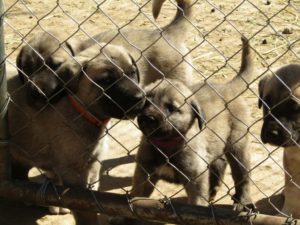


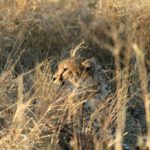





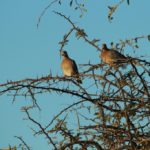
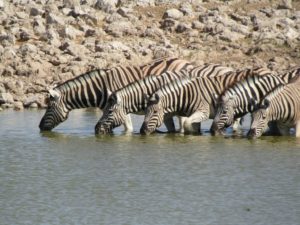
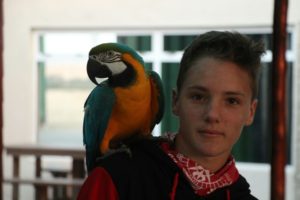

Beth Carlson
22 Jul 2017This is a fascinating look at the cheetah population and their plight in the wild. It is encouraging that two strong efforts are being made, and that one benefits farmers, who also need to keep their goats/livestock alive and well.
Great news about the Dutch family! I think many of us want to believe in the goodness of human nature.
Beth
Eric Adelberger
22 Jul 2017Thanks so much for your blog. It is a real pleasure to see people doing good unselfish things (a huge contrast to our president and his sleazy crew). Your photo of the two zebras was a stunning piece of art!
Eric
virginia garlitz
23 Jul 2017As usual you two know how to travel and to make the most wonderful connections with animals and with people. And your photos are fabulous. Thank you for including us on your voyages.
va
Stormy Burns
23 Jul 2017So glad you went on this adventure so that I might be an armchair traveler. Even more glad you are back safely! And loved the “mirror-image” zebras”!
Janie Smith
6 Aug 2017Great photos and an amazing trip. So what have you got planned for August??
Glad you are safe at home now 🙂
Robin
8 Aug 2017Have just now read all your insightful posts and absorbed your beautiful photographs. What a wonderful eye and heartful!
Thanks so much for sharing.
We look forward to hearing more stories and seeing your new collection of artifacts. And perhaps meeting up again with our boats somewhere up north!